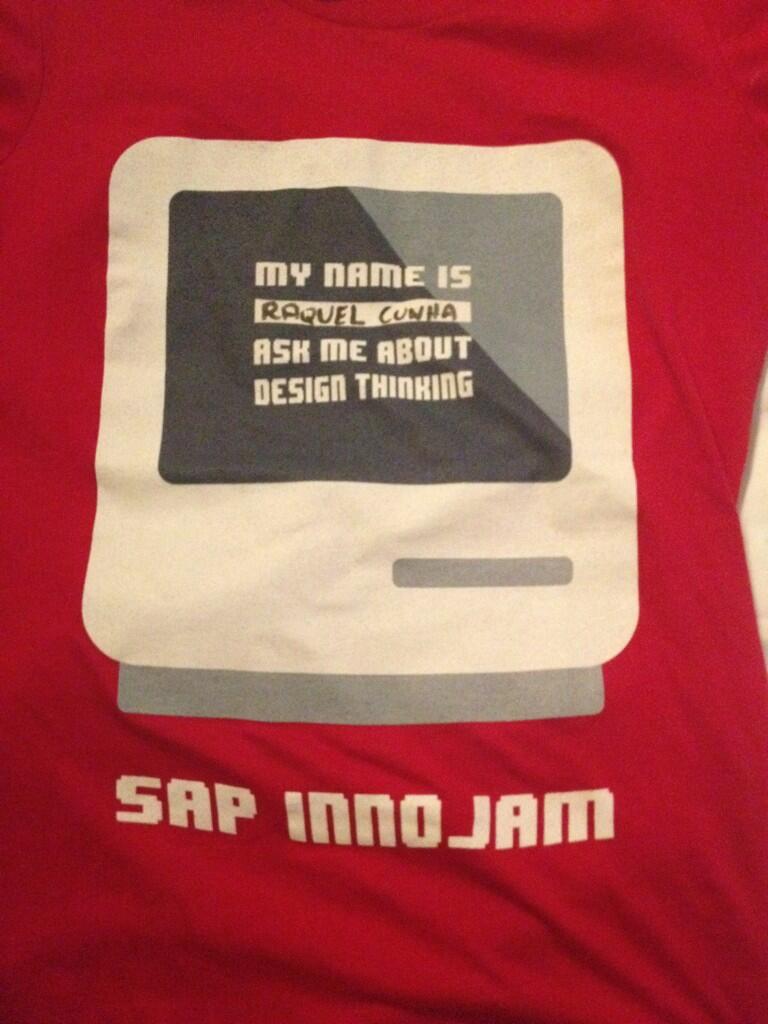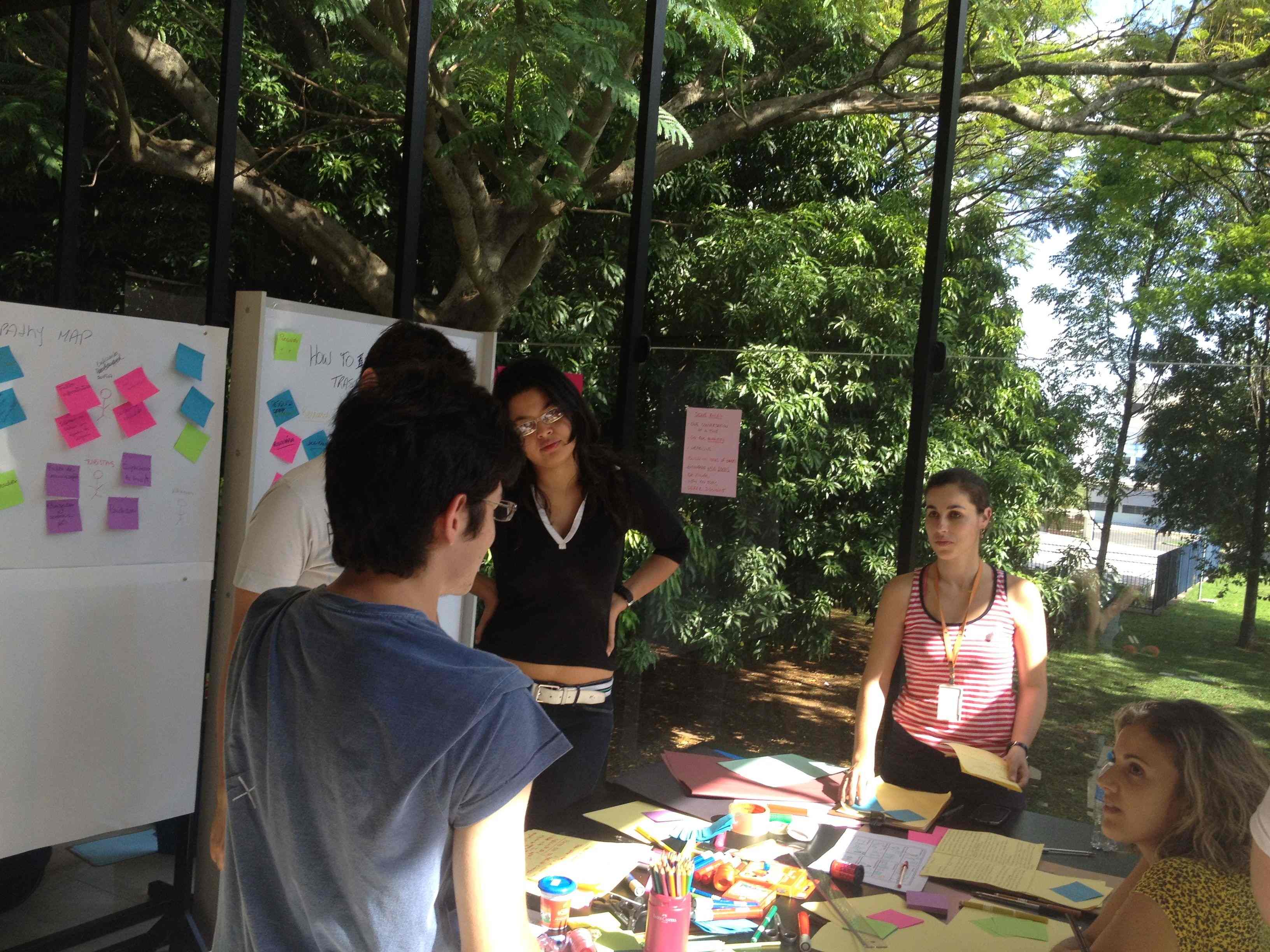
- SAP Community
- Groups
- Interest Groups
- Application Development
- Blog Posts
- Design Thinking in Brazil-A weekend with students-...
- Subscribe to RSS Feed
- Mark as New
- Mark as Read
- Bookmark
- Subscribe
- Printer Friendly Page
- Report Inappropriate Content
This is the second blog of the series Design Thinking in Brazil - a weekend with students.
In the first blog I explained what is the idea behind the “Design Thinking in Brazil” project and how was the preparation for the weekend workshop. In this blog I will describe all the activities performed during the first and second days in São Carlos. In the next and last blog I will describe the last day.
Day 1
In the first day, Friday evening, we had all the students that were going to attend the workshop on Saturday and Sunday (the selected students) and also other people that wanted to have some contact with Design Thinking for some hours. This part of the project was open to the public, so we had people from companies such as 3M and Bosch, professors and students that registered for the workshop but were not selected.
Prof. Rozenfeld started the evening with a big welcome to all and introducing the team behind the workshop. Then Ljubow talked a little bit about her experience at Hasso-Plattner-Institute, explained what Design Thinking is and its processes, using the pictures from the HPI School of Design Thinking, as we can see below. She also played some videos.
 |  |
After her explanations, I talked a little bit about the introduction of Design Thinking at SAP as a product definition methodology, explaining that DT has become an integral part of SAP’s development philosophy 1.I talked about User Experience strategy at SAP 2, SAP Fiori, Screen Personas, Usability Tests (I have participated in one Usability Test during SAP Teched and really enjoyed), Design Thinking at InnoJams and the SAP UX Design Services. I also mentioned the AppHaus and how SAP invests in Creative Work Environment to enable Design Innovation.
1: https://experience.sap.com/post/show/48
2: https://experience.sap.com/post/show/111
After me, Korbinian, the other volunteer coach, talked about Design Thinking for Social Innovation. One of the things he said was: "Social Innovation means to be responsive to social inequality and basic needs". Then, Ljubow was in charge again and explained the idea of the Design Thinking in Brazil program, what we were going to do in the next 2 days and what we would like to do next year.
The last part of the evening was very interactive. Ljubow coached the attendees in an iteration of the “Wallet Project” of d.school Hasso Plattner Institute of Design School, a famous and fun activity in which each of the attendees (split in groups of 2) had to design the ideal wallet for his/her pair. This introduction to Design Thinking takes one hour and makes the people experiment all the processes of Design Thinking in a very simple and quick way. I was helping as one of the Facilitators in this activity. It was a very nice evening.

Day 2
The next morning was the beginning of the Design Thinking workshop. The three of us, coaches, prepared the space, which was a nice building with glass walls surrounded by trees, with whiteboards, flipcharts and long and large tables, materials for brainstorming and prototypes, including lots of objects that we brought from home to make the environment more informal and funny. There were also a wide screen TV, a laptop plugged to an acoustic box playing music and some couches and low tables in a coffee break area. We unfortunately didn’t have elevated tables, but the space was enough for all the team members to participate.
I like the sentence below taken from “Make Space”, book John Wiley and Sons:
“Space is the “body language” of an organization.*
Intentional or not, the form, functionality, and finish of a space reflect the culture, behaviors, and priorities of the people within it.”

As one of our sponsors for materials was 3M do Brasil, we had lots of Post-it® of different types, some of them not yet released in the Brazilian market. They wanted us to try it and give our feedback. Below there is a picture of the different Post-it® we had, such as BIGPAD and Super Sticky.

The selected students arrived and we distributed the tags with their names, with a color for each group. After participating of the InnoJam in Amsterdam this year I think a t-shirt with their names written on it like the Innojam participants would be great. But we didn’t have budget for that :neutral:
My t-shirt as a DT coach in Amsterdam is shown below:

The first activity was a Welcome Talk where the agenda of the two days was briefly explained. Then we went outside for a Warm-up. It was a beautiful sunny and warm day and we did some games and exercises all together. That made us all more comfortable and closer.
Back to the building, each team started the work in their spaces. We introduced ourselves and the coaches introduced the team rules. Some of the rules were:
- One conversation at a time
- Be visual
- Go for Quantity
- Build on Ideas of Others
- Defer judgment
- Encourage wild ideas
- Focus on topic
Some of these rules I repeated many times during the 2 days, and it was very important.
Back all together, Ljubow introduced the challenge and the process of Research, explaining Understanding and Observation. The challenge was “How might we improve the transportation experience in São Carlos?”. As in this 3-days workshop we didn’t have any partner giving a real problem or challenge, the organizers during the 2 weeks of preparation asked the students at USP what problem they would like to solve. Most of them mentioned the transportation.
Next, the teams went to their spaces and started the Research. The most important was to have a common understanding about the challenge, and to plan the observation phase. My team decided to split in small groups (including me) and prepared the interviews and the destinations. Each pair went to a different place in the city to interview, observe and capture. One group went to the bus station (there is no metro in São Carlos, only bus), one went to the main avenue in downtown trying to get a ride to the other university, UFScar (Universidade Federal de São Carlos) and I went with another student to some stores and bus stops asking questions such as how they get to the job and back home and what are the main problems. It was interesting to see how they open themselves when they see you are available to listen and willing to make their experience on transportation better. Nobody that we talked to skipped the questions or didn’t want to talk. We also observed people waiting for the bus, and after walking a lot under a very hot Sun and 30C we took a bus back to USP and could interview the guy that works selling the tickets inside it.
Back to the building after a lunch break, all participants played a game called Marshmallow Challenge. Each team had to build the highest tower possible using some spaghetti. They had a lot of fun.
 |  |
After that, Ljubow introduced the next activities that are part of the Synthesis phase: storytelling, empathy map, clustering, persona and point of view.
Back to the team spaces, each team started the storytelling sharing the most important things they learned during the researches. They should look for surprises, contradictions and tensions using an Empathy Map for the different people they interviewed and then cluster the most intriguing insights trying to define their persona.
Empathy Map: what each person says, thinks, does and feels. Sometimes what a person says is different from what he/she thinks and does, and what he/she does is different from what he/she really feels. One of the things the participants needed to do during the Interviews and Observation was to try to get the person's feelings.

A persona must have a name, age, what he/she does, what he/she likes, what are his/her needs. It does not need to be a real person, but can be a merge of the different people they met or observed. The persona will be the user who will be benefited by the service or product they will create. When they have the user, his/her needs and the insights they clustered, they have a Point of View.
 |  |
Then, with a persona and a point of view, the next activity was to create some HMW questions - "How might we...?". These questions were going to be used during the Ideation phase in the next day. HMW questions are used to launch brainstorming, as explained here. For example: "How might we provide José a more comfortable transportation?", or "How might we help José to arrive faster at his destination?".
After the teams defined the Persona, they had to present it. Each team had some minutes to show the persona and explain the Point of View, what the problem of this persona was and his/her main needs. After each presentation, the other teams and the coaches could ask questions.
We finished the day with the "I like...I wish..." part, where each participant and coach could give an open feedback.
In the next and last blog I will describe the activities of the day 3: Ideation, Prototyping, Test and final presentation.
- SAP Managed Tags:
- Design Thinking
You must be a registered user to add a comment. If you've already registered, sign in. Otherwise, register and sign in.
-
A Dynamic Memory Allocation Tool
1 -
ABAP
8 -
abap cds
1 -
ABAP CDS Views
14 -
ABAP class
1 -
ABAP Cloud
1 -
ABAP Development
4 -
ABAP in Eclipse
1 -
ABAP Keyword Documentation
2 -
ABAP OOABAP
2 -
ABAP Programming
1 -
abap technical
1 -
ABAP test cockpit
7 -
ABAP test cokpit
1 -
ADT
1 -
Advanced Event Mesh
1 -
AEM
1 -
AI
1 -
API and Integration
1 -
APIs
8 -
APIs ABAP
1 -
App Dev and Integration
1 -
Application Development
2 -
application job
1 -
archivelinks
1 -
Automation
4 -
BTP
1 -
CAP
1 -
CAPM
1 -
Career Development
3 -
CL_GUI_FRONTEND_SERVICES
1 -
CL_SALV_TABLE
1 -
Cloud Extensibility
8 -
Cloud Native
7 -
Cloud Platform Integration
1 -
CloudEvents
2 -
CMIS
1 -
Connection
1 -
container
1 -
Debugging
2 -
Developer extensibility
1 -
Developing at Scale
4 -
DMS
1 -
dynamic logpoints
1 -
Eclipse ADT ABAP Development Tools
1 -
EDA
1 -
Event Mesh
1 -
Expert
1 -
Field Symbols in ABAP
1 -
Fiori
1 -
Fiori App Extension
1 -
Forms & Templates
1 -
IBM watsonx
1 -
Integration & Connectivity
10 -
JavaScripts used by Adobe Forms
1 -
joule
1 -
NodeJS
1 -
ODATA
3 -
OOABAP
3 -
Outbound queue
1 -
Product Updates
1 -
Programming Models
13 -
Restful webservices Using POST MAN
1 -
RFC
1 -
RFFOEDI1
1 -
SAP BAS
1 -
SAP BTP
1 -
SAP Build
1 -
SAP Build apps
1 -
SAP Build CodeJam
1 -
SAP CodeTalk
1 -
SAP Odata
1 -
SAP UI5
1 -
SAP UI5 Custom Library
1 -
SAPEnhancements
1 -
SapMachine
1 -
security
3 -
text editor
1 -
Tools
17 -
User Experience
5
| User | Count |
|---|---|
| 5 | |
| 3 | |
| 2 | |
| 2 | |
| 2 | |
| 2 | |
| 1 | |
| 1 | |
| 1 | |
| 1 |